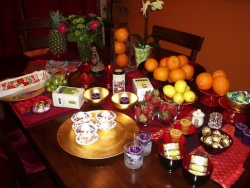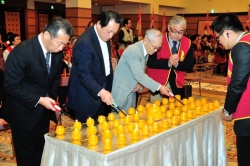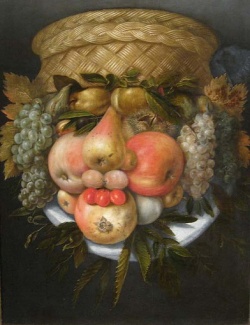Initiatory Automatism
1.Introduction to practice
Automatism is a unifying word for different forms of techniques that relates to practices such as automatic writing or automatic painting: the process of acquiring and in different forms manifesting messages, from unknown aspects of the mind, different kinds of entities, the souls of the dead or initiatory beings which one is in contact and communication with. After having been transcribed on paper or in other form manifested; as paintings on a canvas or recorded as glossolalia or music, the message conveyed is used as a tool as one of the parts of the esoteric process one is at the moment investigating.
The work unfolds in three parts:
- 1) The operation of transmittance - how to accomplish the automatism itself.
- 2) The transitional stage - how to expand on the results for art or initiatory work.
- 3) Operations of initiation - the varying use of the results in an initiatory way
The word Automatism as such is historically most clearly connected partly with the brittish witchcraft-artist Austin Osman Spare, who incorporated these kinds of techniques into many aspects of his esoteric system, partly to surrealist or dadaist art movements who with a variying degree of success used techniques of automatism as part of an introspective psychology with the overall motivation of digging down into the subconsciousness and bring what could be found back up, and then use that in a process of over-bridging gaps and borders within the consciousness.
The results achieved when working with automatism is often of a sort that mildly can be described as fuzzy. Just like its cousin technique Ouija, there are overshadowing problems that results in different degree can be filtered and thus marked by aspects of the consciousness that one really does not want the information to pass through in such a manner, a problem one through more in depth study of the technique can learn to identify and bit by bit get rid of. This is why working with this field of techniques is easier after and during initiation into 3.0. Samael.
The problem is not only of an inner kind; it can happen that one for instance instead of getting in contact with a desired nature spirit establishes contact with a general stream of astral noise, or another spirit. Honesty, doubt, openness and an ability to critizise ones own results are extremely important when working with this from an initiatory perspective, which is quite different than only using it as a bank of inspiration for weird art. Especially after a working of transmittance has been completed and the transitional stage of preparing for initiatory action has begun, one will really need to investigate the results quite throughly using the above mentioned abilities.
Central to the work with automatism is thus that the initiate in connection to the transmittance operation has a high level of vital esoteric energy that makes it possible for the magician to let the mind be widened from its usual state, being able to open closed doors within the corners of the mind; to shut down some aspects of the consciousness which is not needed outside the realm of Malkuth. Thus the work with the Inner Fire in its many forms within other esoteric traditions should be emloyed not only during the operation of transmittance, but also before and after it: the clarity of the mind when elevated by the the Inner Fire should be gathered over time for the operation and then used as a part in the analytic process of transitionaling the results into initiatory work. Since the Inner Fire is so important to the esoteric process it will probably also be used in the initiatory practices that will commence.
Within the operation of transmittance, the Inner Fire should be awake from the beginning, followed by specific invocations, sigils, mantras or singing to be employed when for instance getting in contact with a specific spirit. Thus said; automatism is not a practice of its own, but rather a practice to be used side by side with other esoteric techniques.
Automatic writing and painting often coincide with each other, it is not unusual that an operation that at first begins with a process of scriptual transmittance then results in a cacaphony of undecipherable text, sigillisations and works of art. Initiatorily interesting works of art also tends to be quite primitive from a stilistic point of view, why there might be a point of advancing the transmitted works during the transitional stage before initiatory work commences. The state of consciousness during the transitional stage need not necessarily be the fruit of ritual and meditation, but could rather be the result of being alone, painting, listening to music that corresponds to the work at hand, with some insence lit. Thus; a state of inspired artistry. This is to be worked in tandem with the more analytic and doubtful state of mind. Guidance from the Inner Fire and the alliance with the spirit should also be saught: spontaneous inspiration, stilistic questions and initiatory understanding should be combined on the canvas; on the paper or in the music. Contrary to the operation of transmittance, this work is best done with eyes open.
The way to take the leap to use the material gathered in an initiatory way varies from operation to operation. The only thing worth mentioning here is the continued work with the Inner Fire and the Draconian esoteric tradition in general. This will put the results gathered from the automatism in context. It will be the soil of Khem where one will reap the harvest of initiation.
Here are some ways of using the results in an initiatory way:
- 1. A finished painting could be used as a portal for astral workings. Before going to bed, candles can be places before the painting so that it is clearly visible when one is outside the body and able to enter it.
- 2. Power-words received from automatic writing could be used in invocation or on the astral plane to get into communication with the spirit, or to unlock certain blocks.
- 3. Sigils can be used to enter specific places of the astral plane.
- 4. A painting could be used as a fetiches for a specific entity and be activated through specific formula received.
- 5. Esoteric writings might be received in the manner of Angelium and be used as a holy text for approaching specific entities, the Daimon or certain aspects of reality.
2. The Operation of transmittance
2.1. The tool of transmittance
The tool one is using when performing automatic writing could be a simple pencil, but there are valid reasons why one should set apart a specific pencil that is used only in these operations or even only in operations concerning a specific spirit. The pencil is concecrated and cleansed ritually in the manner the initiate is most well versed. The sigil of the spirit can be drawn on a smaller paper rolled around the upper part of the pen and fastened by some kind of thin string. Other corresponding objects such as metals, certain flowers or something else that corresponds heavily to the spirit at hand might be fastened in the same way.
When the pencil is not active it can be put to rest on the sigil of the entity only to be lifted when the operation of transmittance or even aspects of the operation of transition is at hand. The pen could be lifted through the smoke of corresponding incence and if the initiate is using invocation she might gently blow out some air from the spirit inside her over the pencil so that it will move swiftly under the control of the entity. Notice that some spirits is not pleased with certains forms of metals or other materials, choose wisely and make sure to get to know the spirit. Given the fact that many pencils are made of metals; pencils often contain lead, it is sometimes wise to use a feather and ink. A brush and a canvas can of course be employed already in the operation of transmittance, but it bears with itself some specific problems which will be more clear when one have tried it: the process of applying more paint of different colors as well as the process of blending the colors is hard to combine with a deep state of consciousness. [[File:Arhats-550.jpg|thumb|250px|]] For those who does not wish to use a pencil one might of course use more modern means, if the spirit is pleased with that. Such as a keyboard connected to a computer. However, the freedom it means to be able to dash over the paper and create sigils and art is compromised in this form. Instead one might choose to use digital tablets for automatism. The paper used can be of different formats. It must however be quite easy to swap pages when one has filled one up or a new specific message is to be conveyed that should stand out in its own context, not to be too interrelated with the other parts of the message. The paper should of course in most cases be without premade lines.
For those wishing to work with music not much information can be given since we have not yet undergone any experimentation in this field. Maybe some of the information given in this text can be of use also in such operations.
2.2. The writing hand
Even if we are walking the Left Hand Path, that does not mean that the operations at hand needs to be done with the left hand, though experimentation with using the other hand can and should be carried out if one in a deeper sense is interested in exploring this set of techniques. Some experience it as easier to do automatism with the other hand and explain it in manners such as it is easier to let the filters that one wants to shut off be shut off when using it, using the right hand makes it so that the mind always try to get control and filter again. Others again experience that it is completely impossible to descipher the messages afterwards when doing it this way.
On the hand sigils can be drawn, and the invocatory powerwords could be written around the arm in a spiral ending at the fingers who will be holding the pencil, or ending at the sigil painted on the hand. Always try the colors out on the skin before doing it in ritual. Another variant for those who does not want to wash themselves afterwards is to write the powerwords on a spiral fabric that can be rolled around the arm.
2.3. The beginning of the transmittance
There are many techniques that can be employed after having done the type of preparatory practices written about in last chapter. Some of these techniques are well suited to be combined with each other. For most people it is beneficial to close the eyes when working with this. Always make sure to have the Inner Fire active.
2.3.1. First signs
Hold the pencil in your hand and start doing a sort of motion on the paper that creates some kind of repetetative pattern such as a circle, one or many interconnected eights or similar. When contact with the spirit becomes intense; use the name of the spirit as a powerword, lead the Inner Fire into the hand, aimed by the sigil, and let the pencil glide out of the pattern before created and begin the automatism. It might so happen that the contact becomes so strong that you will have no way of controlling the hand at all, and thus this happens by itself.
2.3.2. Invocative writing
In the early part of the operation, you can let the pencil freely move about over the paper, writing down powerwords, parts of the invocation or draw the sigil of the entity. In the same way as one approaches a pathworking where you will experience that you visualise yourself through a series of specific places and situations leading to a situation where one gets more and more detached from the thought trough creation of the visualisation and experience how the visualisation is carried on by itself; like in a dream, often under the guidance of an entity or a force, one might also do in automatism. In this case the pathworking is graphed down and carried out together with the rest of the invocative writing. Thusly; written powerwords and sigils leads the pencil to draw a portal, leading to a spiral that goes downwards, continuing deeper and deeper into the experience until the automatism takes over. In this way the actual invocation is even more connected to the hand.
2.3.3. Hand postures
During the preparatory stages of the work, the initiate is sitting in a posture of meditation in such a way that the writing hand holding the pencil is lifted right upwards. After prolonged time in the posture it will lead to a sensation in the arm that one is not accustomed to. This sensation is well suited for the switch of control over from the initiate to the spirit; the spirit does not have to fight so hard to take control over the hand. Further; if the entity is connected to a certain hand posture, such as the eastern mudras, this posture might be possible to combine with the work.
2.4. Communication
This can be combined with 2.3.2. but works also at particular instances when the mind is very close and in some sort of contact and communication is taking place. What one does is to break off in the middle of the writing process and give questions to the entity, writing them down and or speaking them out loud. Hopefully, the spirit may then answer these questions by taking control over the hand. If possible, use follow up questions. This can also be combined aspects of 2.3.1. or even 2.3.2. when the question has been spoken.
2.5. Wake dreaming automatism
Aside from the states of mind that is generally the starting point of invocation, Inner Fire and general meditation, other states of mind can be combined with automatism. One of those is wake dreaming, that are more clearly outlined in the text Astral Journeys based on some of the work on the Yoga of the Illusory Body within the Six Yogas of Naropa tradition of Tibetan Buddist Tantra, written by the Tantric Circle of the Lodge. See part 1.5. in that text for some background information on how to approach the technique and experiment with it before trying to combine it with automatism in for instance this manner:
Before the waking dream is beginning, a series of preparatory techniques are ritualised in more or less the same way as described in the introduction. However, with the difference that one will make a short break to lay oneself down on a place optimal for wake dreaming such as a bed or a thick carpet.
At this instance one works with Astral Journeys 1.5. By ones side one should have a large format paper on a hard surface. A paper should be placed in ones hand or resting near or close to the paper. Maybe resting on a sigil of the entity already drawn in a meditative state. The sigil could also be drawn in a light color as a background on the paper so that it is easy to distinguish from the transmittance: it can easily be overdrawn without much of an issue concerning what is what afterwards. When the state of wake dreaming unfolds one will use mental powerwords, perhaps combined with one or two breaths to ignite the Inner Fire. When contact is reached one will combine the wake dream with any of the above mentioned techniques in 2.X.X except 2.3.3.
Don't forget to close the gates when the work is finished. If one falls asleep, one should at waking up directly close the gates or continue with the practice.
3. An example
1. An area which one seeks initiation into is identified by the adept. It might be general things or more specific tasks such as how to be able to attain a certain state of mind related to a Qliphothic sphere that one before has slipped into before.
2. An entity is well chosen to be approached with the possibility of establishing an alliance that might be beneficial for reaching the desired initiation.
3. The techniques to be used for contact with the spirit is set up and set into motion. It might for instance be a combination of Inner Fire, invocation, evocation, astral projection with astral evocation, automatism, sigillisation, mantra or singining and opening of the Qliphah related to the spirit, and contacting the Demon-ruler that governs it.
4. Contact and communication with the spirit is reached.
5. An operation of transmittance is carried out.
6. The transitional stage of preparing the results for initiatory practice is commencing. The results are screened through honesty. If the results seems interesting they might be expanded upon. The primitive drawings might become paintings instance and then used as portals in Astral Workings. Text might be incorporated into invocations or be used as a guide on how to approach the initiatory knowledge one seeks to unravel.
7. The results from the transitional stage is put into initiatory action, often resulting in new information, new art, new realisations:
Thus a spiral of Visio Vires Actio is at hand.






